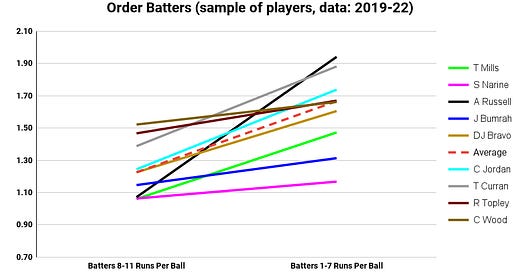Death Bowling Context And It's Impact On Performance
Jack Hope takes a look at how different contexts have an impact on a death bowler's likely outcomes.
A really quick article this time on how the context of a match can have a drastic impact on expected outcomes. This one was inspired by watching London Spirit’s opening two matches, and noting how remarkably differently their bowling unit performed v the Invincibles and v the Originals. In the end though, it isn’t really about them, and is a lot more general.
Support The Show!
Just to flag, that you can support The Cricket Podcast by signing up on Patreon! For just £4/$5 you get: exclusive shows, special Q&As, access to our private Discord and more. You can also find us on Twitter here (@JackHope0) and here (@TheCricketPod).
PLUS we can sort you out with the best of men’s below the waist grooming at MANSCAPED.com. Use the code: CRICKETPOD for 20% off plus free shipping.
No doubt that anyone who has watched much of The Hundred will have noticed the extreme variance in player performance from match to match. Death bowling may be the most obvious example of this, as the context in which a bowler bowls can change so significantly. Below I’ve added a chart showing a selection of bowler’s performance at the death versus batters 8-11 and batters 1-7. The red dotted line is the baseline average for every bowler who has bowled 90 balls to the top 7 (1.67 rpb) and bottom 4 since 2019 (1.23 rpb).
This gives us a snapshot of how these bowlers go against talented and less talented batters. It also allows us some insight into how the performance of other players in the team can have an extreme impact on a player’s stats in this period. Andre Russell for example, has consistently been among the best bowlers on the circuit to the bottom 4. Line him up against a more capable opposition, however, and he quite quickly becomes cannon fodder.
Unsurprisingly a bowler's ability to take wickets against these two groups of batters has a reasonable impact on their effectiveness. Below shows a comparison between the difference in bowlers RPB conceded v the top 7 and bottom 4 batters, and the difference in average bowling against the same groups (an R2 of 0.407). Taking Andre Russell as a case study again, his bowling average is a colossal 17 runs better against weaker batters.
Rounding everything off, this gives us a few clues to how a captain may deploy certain bowling options at the death. Or where they may have been going wrong, Russell again, bowled 3.4 balls to a top order batter for every one to a lower order batter. The 6th most in the sample of 46 players.
Most neatly, though, it provides a highly digestible example of how we often have to strip away multiple layers of information to establish a player’s true worth in different scenarios.







Incredible work Jack. Very very interesting. Bumrah and Narine like bowlers do show up as the best ones in these data sets, not that they need a proof. This comparison gives a clear strategic idea, although not sure how many captains actually are willing to invest time with planning to the data. Possibly they go with the intuition in tight situations last crunch penultimate overs when 15 runs are needed of last two, unless there is a specific, timey feedback from the dugout. Great work though, thank you :)